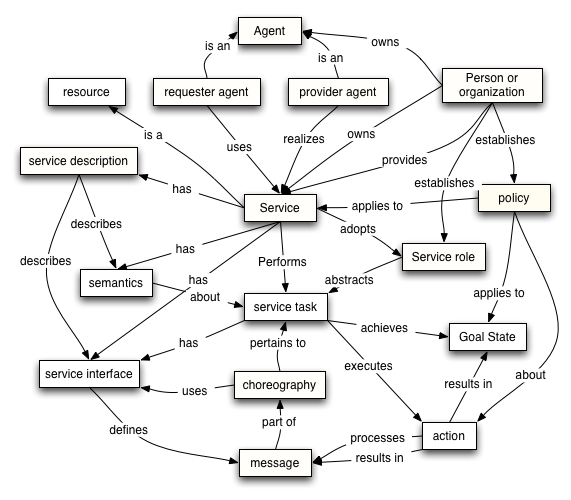
Image: Service Oriented Model
http://www.w3.org/TR/ws-arch/#service_oriented_model
"Where a system determines its own composition, properties and evolution independently of external laws or structures, it can determine its own meaning, and ensure by its self-configuration that its inhabitants are crucially implicated therein.
...
A (Minkowski) spacetime diagram is a kind of “event lattice” in which nodes represent events and their connective worldlines represent the objects that interact in those events. The events occur at the foci of past and future light cones to which the worldlines are internal. If one could look down the time axis of such a diagram at a spacelike cross section, one would see something very much like a Venn diagram with circles corresponding to lightcone cross sections. This rotation of the diagram corresponds to conspansive dualization, converting a spatiotemporal lattice of worldlines and events to a layered series of Venn diagrams.
...
Uniting the theory of reality with an advanced form of computational language theory, the CTMU describes reality as a Self-Configuring Self-Processing Language or SCSPL, a reflexive intrinsic language characterized not only by self-reference and recursive self-dfiinition, but full self-configuration and self-execution (reflexive read-write functionality). SCSPL reality embodies a dual-aspect monism consisting of infocognition, self-transducing information residing in self-recognizing SCSPL elements called syntactic operators."
http://www.ctmu.net/
"Using the concept of adjunctive correspondence, for the comprehension of the structure of a complex system, developed in Part I, we introduce the notion of covering systems consisting of partially or locally defined adequately understood objects. This notion incorporates the necessary and sufficient conditions for a sheaf theoretical representation of the informational content included in the structure of a complex system in terms of localization systems. Furthermore, it accommodates a formulation of an invariance property of information communication concerning the analysis of a complex system.
Keywords : Complex Systems, Information Structures, Localization Systems, Coverings, Adjunction, Sheaves."
http://philsci-archive.pitt.edu/1237/1/axiomath2.pdf
"Relativistic programming (RP) is a style of concurrent programming where instead of trying to avoid conflicts between readers and writers (or writers and writers in some cases) the algorithm is designed to tolerate them and get a correct result regardless of the order of events. Also, relativistic programming algorithms are designed to work without the presences of a global order of events. That is, there may be some cases where one thread sees two events in a different order than another thread (hence the term relativistic because in Einstein's theory of special relativity the order of events is not always the same to different viewers)."
http://en.wikipedia.org/wiki/Relativistic_programming
"Event-driven architecture can complement service-oriented architecture (SOA) because services can be activated by triggers fired on incoming events. This paradigm is particularly useful whenever the sink does not provide any self-contained executive.
SOA 2.0 evolves the implications SOA and EDA architectures provide to a richer, more robust level by leveraging previously unknown causal relationships to form a new event pattern. This new business intelligence pattern triggers further autonomous human or automated processing that adds exponential value to the enterprise by injecting value-added information into the recognized pattern which could not have been achieved previously.
Computing machinery and sensing devices (like sensors, actuators, controllers) can detect state changes of objects or conditions and create events which can then be processed by a service or system. Event triggers are conditions that result in the creation of an event."
http://en.wikipedia.org/wiki/Event_driven_architecture
"An individual software component is a software package, a Web service, or a module that encapsulates a set of related functions (or data).
All system processes are placed into separate components so that all of the data and functions inside each component are semantically related (just as with the contents of classes). Because of this principle, it is often said that components are modular and cohesive."
http://en.wikipedia.org/wiki/Component-based_software_engineering
"Service-oriented modeling typically strives to create models that provide a comprehensive view of the analysis, design, and architecture of all 'Software Entities' in an organization, which can be understood by individuals with diverse levels of business and technical understanding. Service-oriented modeling typically encourages viewing software entities as 'assets' (service-oriented assets), and refers to these assets collectively as 'services'."
http://en.wikipedia.org/wiki/Service-oriented_modeling
No comments:
Post a Comment